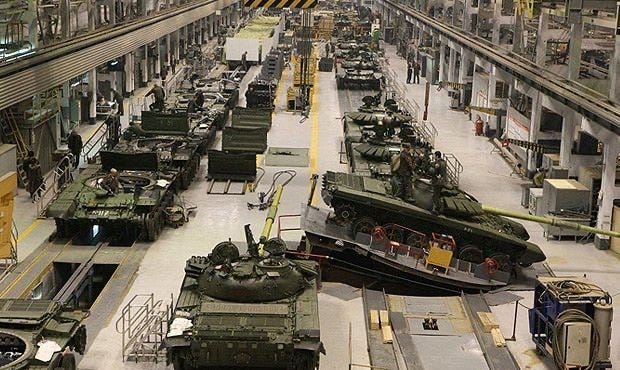Sanctions really began to prove their worth in war-fighting when the Russian tank manufacturer Uralvagonzavod was forced to cease production this week. The factory, located in the town of Nizhni Tagil in the Ural mountain range about a thousand miles from Moscow, has more than 30,000 employees and is said to be the largest maker of tanks in the world.
What caused this modern plant to cease operation? You guessed it: they ran out of computer chips. So did another factory in the same town that makes tractors. They ran out of chips, too. The modern tank, like the modern automobile, is really just a rolling platform carrying computers that enable it to get from point A to point B. A standard passenger car can have as many as 30 to 50 different computers managing everything from the temperature and oxygen content of the air its engine takes into its fuel injection system to tire slippage on icy or wet roads. A high-end car can have 100 computers, and most of them run systems employing sensors that tell the computers what’s going on.
Modern tanks can’t start up, move and shoot without many of the same kind of computers and sensors cars make use of. Uralvagonzavod is a state-owned company that makes the T-72B3 as well as the more advanced T-80 and T-90 tanks. All three tank models have been used by the Russian army in its attack on Ukraine. Replacement parts for tanks already in service are also manufactured by the giant tank company, and those lines have been shut down, too.
On Monday, the Ukrainian military claimed that it had destroyed or captured 509 Russian tanks and armored personnel carriers. Without replacements for those fighting machines, the Russian army combat capability is severely limited. Ukrainian forces have been able to take out Russian tanks using the Javelin anti-tank missile system being supplied by the U.S., and a lighter, more easily transportable missile supplied by Great Britain. The Ukrainian military has also used drones carrying “smart” bombs supplied by Turkey to take out armored vehicles.
Here is why the sanctions have been so effective. Modern tanks use multiple systems to aim and fire their main guns and are defenseless without them. The gun and turret are connected to a system of gyroscopic stabilizers that enable the gun to be fired while it is on the move over rough or smooth terrain. There is a gyro-sensor computer that tells the main gun firing system what is the tilt of the vehicle, which is necessary to keep the gun-tube aimed in the desired direction. There is another gyro-sensor that tells the main computer how fast the turret is traversing to keep it aimed at the target. For the main gun aiming system, there are sensors and computers that measure crosswind, air temperature, barometric pressure, and ammunition temperature, because gun powder burns faster when it’s hot than it does at lower temperatures. There are laser range-finding systems that lock on targets and tell the turret and gun-tube how high or low its angle must be to achieve a hit. And there are sensors for both the tank’s speed and the speed of the target in the gunner’s sight.
All of this stuff is added and subtracted and multiplied and divided using dozens of individual computers in order to aim the gun. The tank’s main ballistic computer integrates all the information coming from the component computers and sensors to determine where the tank is at any given moment and predicts using the target’s speed where it will be, so when the main gun is fired, the tank’s armor-piercing warhead will find and destroy its target.
It didn’t used to be that way. When I was at Fort Knox back in the mid-1960’s, the only computers in a tank’s firing system were the gunner’s eyes and hands. Looking through a sight, the gunner estimated the distance to the target and moved the gun barrel up and down accordingly. The same with the speed of the target if it was moving, “leading” the enemy tank or other vehicle using the sight so when the gun fired, the warhead would meet the target where the gunner estimated it would be using his experience and his eyes. A gunner sat in the turret next to the main gun looking through a heavily-padded sight holding what amounted to a steering yoke with a firing button. It was all human, and was only as accurate as the gunner, which is why practicing over and over and over again was so important.
Believe it or not, this is what I did as a 20 year old cadet: I was in charge of training a company of 160 young American soldiers how to do this in 50 ton chunk of moving steel.
Today almost everything a 19 year old soldier used to do is done by a computer. Russia is running out of the computer chips necessary to make a tank move and shoot, which means that today’s gigantic chunks of armored plate and motors and guns that comprise a tank can’t start their engines much less move on a battlefield and shoot at the enemy.
Russia can’t even manufacture the tractors that plant and plow its wheat fields because they use GPS and various sensors and computers in order to start and run their engines and aim themselves down a row of crops.
Wars aren’t fought by sweaty 19 year old soldiers anymore unless they’ve got computers to help them. Russia’s defense industries are coming to a grinding, painful halt, and it’s all happening because sanctions are doing it without firing a single bullet.





Another excellent post. Thank you. This is exactly the kind of understanding I _don't_ get from the New York Times or The Washington Post.
Gratifying to see sanctions work so quickly